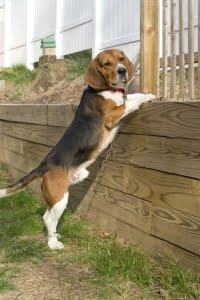When Dogs Roam
We ask much of our 21st century canines. We confine and constrict them to a minuscule morsel of mother earth in our back yards, thinking little of their yearning for the freedom of the open spaces that were once the provinces of their ancestors eons before.
We leave daily for work, always at the same time and always in the same manner, with Fido watching every repetitious move. The poor old pooch is left alone, day after day, in the same old back yard, in the same old way, at the same old time.
You probably take Fido for walks along the street, even on a daily basis. Fido will enjoy that for sure, but on your return, you discard Fido in the boring old back yard again. The street is interesting, stimulating and changing, associated with adventure, fun and excitement. The backyard is ….. dull, boring, routine and uniform, associated with the hum drum ‘normalness’ of life. Nothing changes, nothing happens, no excitement occurs.
Escaping from Back Yard Boredom Blues
So, it is far from surprising that backyard boredom is an increasingly common ill with dogs. It is also not surprising that the wanderlust often strikes and Fido flees for the freedom of the fiords, to explore, have fun and to enrich his own lifestyle!
However, if you allow Fido such freedom, problems are bound to arise. Dogs which are allowed to roam usually have a short life span and are never popular. They are often seriously maimed or killed by cars. They are commonly baited or shot because of the nuisance they cause and they often roam so far that they become lost or stolen, never to be seen again.
You have several solutions that you can utilise to prevent your dog from roaming the street. The easiest and most obvious solution is to construct a fence that is secure enough to keep your dog in your own property and out of your neighbour’s. However, you should also think about the boring nature of the backyard and do all you can to solve that problem and whether having the pet neutered will help.

A good fence will solve most problems and the rule the ‘bigger the better’ is a reasonable one.
‘What not to use’ is the first consideration. Chicken wire is not suitable for a dog enclosure as it is too weak and barbed wire should never be considered. Mesh with wide gaps is also a danger as a dog that has a need to escape can often stretch the mesh sufficiently to get its head and neck caught. The results are often very dangerous.
A chain mesh and pipe fence is the standard type of dog fence, and is probably the cheapest. It should have a tension wire at ground level to which you should securely attach the mesh, and another at the top. Ideally, you should install a horizontal pipe at the top of the fence as this will give additional strength.
A picket fence makes a good dog enclosure, especially as it partially obscures visual access to the street outside, thus reducing barking. However, there is a significant danger with picket fences. Dogs which try to jump fences often get their paws lodged between the pickets at the top of the fence. I have known dogs that have died from being caught in such fences when their owners were away. You can easily prevent this danger. All you need to do is to cover the gap between each picket at the top with a horizontal paling, running the entire length of the fence.
Special Fences for Ballistic Barkers
For dogs that are chronic barkers, a solid fence, usually a wooden one, is well worth consideration. The common ‘good neighbour’ fence is ideal.
Dedicated ‘Pavarotti Pooches’ also benefit by being secured away from the boundary fence facing the main cause of barking. This is usually, but not always, the street. Such fences commonly extend from the side of the house, leaving a dog-free front garden and a doggy back yard. Having achieved this, enriching the back yard environment is very important. This is discussed later. When distanced from the continual stimuli of the street, many previously noisy dogs become surprisingly quiet and peaceful.
Fences for Escaping Experts
Some dogs are so intent on escaping that they will do all they can to find a weak portion of a fence. If they can’t find one, they will create it.
For such dogs, a secure fence is vital. A concrete footing at the bottom of the fence is easy to construct and will prevent the dog from digging under the fence to escape. It is ideal if you bury the bottom of the fence in the cement, or for pipe and mesh fences, if you can place a horizontal footing pipe just above the concrete footing.
The best dog fence by far is a solid wooden fence, where the horizontal supporting beams are on the opposite sides of the fence to where the dog is housed. Many dogs are able to use the horizontal beams as a ladder to help them get over the fence.

The problem with such dogs is that the more they escape, the more they are reinforcing their own behaviour. For such dogs, the escaping routine can be very difficult to solve.
For those escape artists that jump or climb the fence, sometimes making the fence higher is not the answer as they still manage to jump or climb. The best solution is to construct a ‘lean-too’ section on top of the fence. This is an attachment, angled at forty-five degrees and facing inwards. You can construct this easily by attaching angled steel to each post and placing chain netting between each angled section.
The effect is that the dog cannot climb the fence due to the angled section, and cannot jump the fence because of the appearance of width the fence now has.
For human safety, ensure that the angled sections are above head height.
Does Neutering Have any Effect on Escaping Behaviour?
Neutering male dogs is an important consideration. One study has shown that, in 90 percent of entire male dogs, roaming is solved after castration. This is because roaming is often induced, at least initially, by the attractive scent of female dogs on heat in the neighbourhood. The territorial perception male dogs develop by urine marking trees and posts while roaming is also important. The more they roam, the more they mark and thus the more they perceive the neighbourhood as their owned territory.
Relieving Backyard Boredom
The routine nature of a suburban dog’s life, as discussed earlier, is a modern day ill. For barking and escaping dogs, providing an enriched lifestyle in the backyard is vital.
On a daily basis, you should play with your dog in your backyard by giving it daily aerobic exercise, ‘brain work’ or mental stimulation and also giving welcome cuddles and companionship. This is a formal program I call the ABC’s Technique and is available in another Facts Sheet.
Briefly, throwing frisbees and balls in the backyard is good and just running and jumping with your dog is good exercise for both of you.

I often advise my clients to use a special dog toy called a Kong Ball. The ball bounces unpredictably and resists a dog’s chewing too. It has a hole in the middle in which tidbits of food can be placed to create even more interest.
To the left, you will see our new Kong – the KONG Wobbler. This one is hugely popular, and is weighted on the bottom so that when your dog knocks the toy over to get a treat, the Wobbler wobbles straight back up into the standing position.
I can supply Kongs you are interested – just click here.
Brain work involves a fun training routine in which you teach your dog to do different things for no reason other than for fun. Teach it to walk along balance beams, to climb over garden furniture and other obstacles, to roll over, crawl and to ‘play dead’. Also encourage your dog to play ‘hide and seek’. For this game you place your dog in a ‘down and stay’ position and encourage it to ‘seek’ you, other members of your family or even tidbits of food hidden around the back yard.
Providing a good lifestyle for pets is not always as easy as it seems. If you are having problems with a barking, escaping, digging or bored backyard dog, contact me for professionally created programs that can give you a happy and content pet again.
